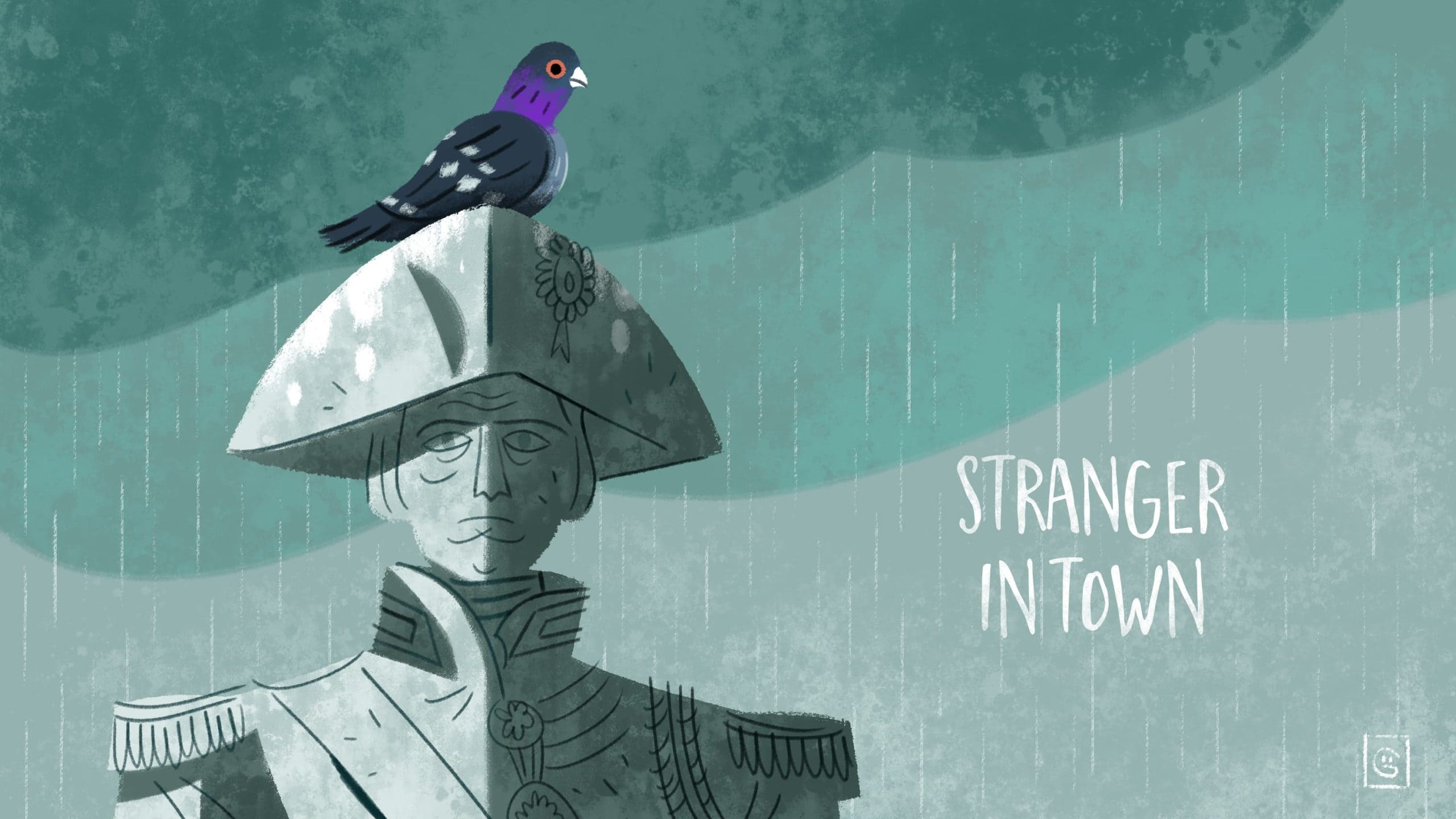

Illustration by Graham Corcoran
London was calling. I knew that. But mockery held the sky that dawn. It was almost dark. The old moon curled like a bashful banana over the coming light. An owl haunted the branches in the middle of his tree. And a high-tailed tomcat strutted the pavements in front of a row of 1930s semis, lust glowing green in his eyes.
Everything was familiar to my eyes. For this was home, near the grand park in a posh-to-middling suburb of an old dock town, where cranes stand in a still ballet, swayed only by memories. Yes, all was familiar. But soon I was to be a stranger, a Stranger in Town – the biggest town in Europe, old London Town. For Stranger in Town is the name of the columns I’m to write for you.
London was calling. I knew that.
I waited by the privet hedge, thumbs tucked under the padded straps of my rucksack. Behind was my wife, whirring the wheels on her suitcase up the drive. We had decided to take the cheaper, close-kneed train to Euston station. And it followed the route laid down by ancient parish pumps, stopping many times along the journey. It took about four and a half hours.
But I marvelled again at the lush, green fields of our country with their horses, cows and duck ponds, church steeples peering over the graves of parishioners. I love this country, where once the milkmaid Mavis sat on a three-legged stool squeezing the udders of Gertrude the cow. Most of the other passengers were pecking their mobile phones – though, when the mood seized them, a few asked for directions to the lavatory, which was out of order, a calamity on a Biblical scale to Britons, corkscrewing their legs and checking their watches.
I love this country, where once the milkmaid Mavis sat on a three-legged stool squeezing the udders of Gertrude the cow.
But we all reached Euston safely enough to be greeted by a teasing drizzle. Indeed, later in the day, when we were in Trafalgar Square, the drizzle had matured into steady rain, persuading gaggles of tourists from all over the world to seek shelter in the National Gallery. I recognised nobody there (except a few of those framed on the walls). We slotted into the lines of gazers while an Australian chap admired a bottom painted by an old master.
My eyes were first arrested by Giovanni Battista Moroni’s painting called A Knight With His Jousting Helmet. The description by it noted the scattering of armour pieces at his feet. But I was more attracted to his black long-johns, which bore a remarkable similarity to the ones under my brown corduroy trousers.
Genius was everywhere, hanging on the walls. “Lucky old Adonis,” I thought, while viewing him in Titian’s painting sitting next to Venus, who had conceived a “hopeless passion” for him. Sadly, however, he ignored her warning not to join some pals hunting a wild boar. This led to him being killed by the aggrieved porker.
We slotted into the lines of gazers while an Australian chap admired a bottom painted by an old master
Still hope for Adonis was not far away. For there was Jesus raising Lazarus from the dead as painted by Sebastiono del Piombo. It seems that Lazarus, who was rather whiffy by then, was also stiff with rigor mortis. And he stared at me with eyes full of shock. “I’m with you all the way, old boy,” I whispered. “My own back is as stiff as a ram-rod. Pain of such magnitude has not been experienced since Joan of Arc met the flames.”
The rain was easing but people kept arriving at our wonderful National Gallery, many speaking in the cathedral tones that are reserved for such places. My soles squeaked on the floor, disturbing the reverie of an art-fancier in a denim jacket. I have seen people like him in other galleries, preening before the masters. Their feelings are oh-so refined.
It seems that Lazarus, who was rather whiffy by then, was also stiff with rigor mortis
Some visitors took pictures of the paintings on their mobile phones – the blinking of a digital eye claiming pictures that have warmed the soul of man for centuries. Outside rain rolled off the statues of brave men who’d been given a kind of immortality by the hands of sculptors. Like paintings they will not die.
A pigeon with a head for heights perched, cool as you like, at the top of Lord Horatio Nelson’s Column, 169 feet (52 metres) from the ground. How our great sailor must have wished he had remembered to place the famous patch over his right eye. But on we go. It’s a strange world for a Stranger in Town.




